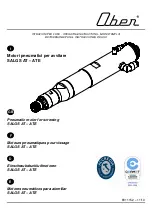
4-15
4-15
4-15
4-15
4-15
Some researchers have experienced a problem with
radioactive contamination
when using
35
S in
thermal cyclers. This problem has occurred with all types of reaction vessels.
The Problem
When
35
S nucleotides are thermally cycled, a volatile chemical breakdown product forms, prob-
ably SO
2
. This product can escape the vessel and contaminate the sample block of a thermal cycler,
and possibly the air in the laboratory. Contamination has been reported with microassay plates,
0.2-ml tubes, and 0.5-ml tubes.
96-Well and 192-Well Polycarbonate Microplates
These microplates present the largest risk of contamination. Polycarbonate is somewhat perme-
able both to water and the
35
S breakdown product. This problem is exacerbated when polycarbon-
ate plates are held at high temperatures for long periods of time, or when the plates are sealed for
oil-free thermal cycling.
0.2-ml Polypropylene Tubes and 96-Well Polypropylene Microplates
These tubes are manufactured with very thin walls to enhance thermal transfer. The thin walls
are somewhat fragile and can “craze” or develop small cracks when subject to mechanical
stress. Undamaged thin polypropylene tubes may also be somewhat permeable to the
35
S break-
down product. Either way, there have been reports of
35
S passing through the walls of 0.2-ml
tubes of several different brands during thermal cycling. No data are yet available on radio-
active contamination with polypropylene microplates.
0.5-ml Polypropylene Tubes
Contamination problems are rarer with this type of tube, but instances have been reported.
The Solution
1. Substitute the low-energy beta emitter
33
P in cycle sequencing.
33
P nucleotides are not subject
to the same kind of chemical breakdown as
35
S nucleotides, and they have not been associated
with volatile breakdown products.
2. If
35
S must be used, three things will help control contamination: an oil overlay inside the
tubes, mineral oil in the thermal cycler outside the tubes, and use of thick-walled 0.5-ml tubes.
Always run
35
S thermal cycling reactions in a fume hood, and be aware that vessels may be
contaminated on the outside after thermal cycling. Please be certain that you are using the
Appendix 4-B
Safety Warning Regarding Use
Of
35
S Nucleotides
Summary of Contents for PTC-0200
Page 6: ...Part I The DNA Engine ...
Page 7: ......
Page 11: ......
Page 23: ......
Page 76: ......
Page 92: ......
Page 96: ......
Page 105: ...Part II The DNA Engine Tetrad ...
Page 106: ......
Page 117: ...Part III Accessories ...
Page 118: ......
Page 125: ...13 7 13 7 13 7 13 7 13 7 The Remote Alpha Dock System Figure 13 5 Flush mounting template ...
Page 129: ......
Page 131: ......
Page 133: ......
















































